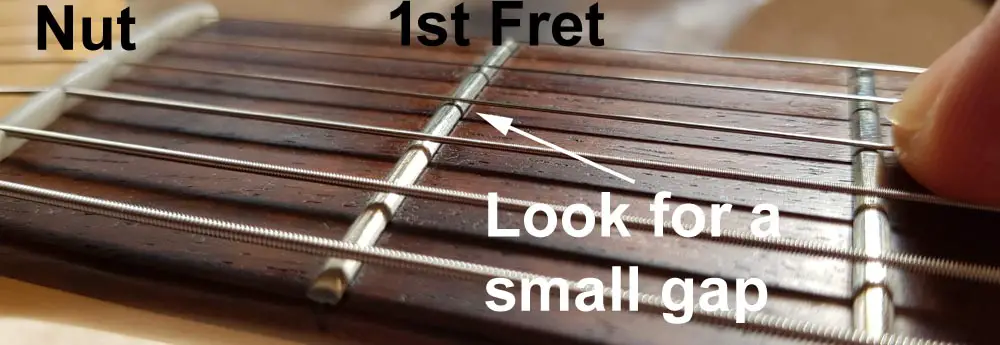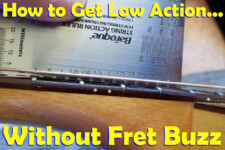Find The Easiest Acoustic Guitar to Play
Acoustic guitars are generally harder to play than their electric counterparts predominantly because their necks are wider.
In addition, the action is typically higher and the strings have more tension, which makes depressing the strings more difficult. So finding an affordable, easy-to-play acoustic can be challenging when you are just starting out.
With a little patience and some shopping around, you can find acoustic guitars that are easier to play than others. Some features you want to look for include: size of the body and scale length, size of the neck, the action, and the type of strings you are using.
I’m going to show you exactly what to look for in an acoustic guitar so you can find your own easiest guitar to play, regardless of the brand.

Why Are Some Acoustic Guitars Easier To Play Than Others?
If you’ve ever picked up a few acoustic guitars it doesn’t take too long to realize that some play really well, and others not so much. The features that give acoustics easy playability are the type of strings, the action, and the neck relief.
Getting these three things under control is what makes a guitar easier to play. But what exactly do these terms mean?
String Action
Your guitar’s action, or distance between the strings and fretboard, should be relatively low so that it doesn’t take much pressure to hold the guitar strings to the fretboard.
The lower the strings, the easier the guitar is to play.
On the other hand, they shouldn’t be so low that they prevent the strings from vibrating. You can tell when the strings are too low because you’ll hear a lot of unwanted string buzz.
The distance between the strings and the fretboard gradually tapers from the nut to the twelfth fret, with the least amount of distance at the nut.
Because the majority of a string’s tension is at the nut, holding the strings at the first fret require the greatest amount of force. Likewise, there is less tension at the twelfth fret, so the action needs to be high enough to prevent buzzing.
- For acoustic guitars, the ideal action is about 7/64″ (2.8mm) from the low E string to the fretboard at the 12th fret.

- At the other end near the nut, an easy way to check for good action is to hold each string at the 3rd fret, and you should see a gap between the string and 1st fret that you could slip a piece of paper through. Too much larger will make the guitar harder to play.

Lowering the Action
If the action on your guitar is too high, you can have it adjusted by a guitar technician. While experienced players may do this themselves, it’s not recommended for beginning guitarists.
Some guitarists will lower the action at the nut by filing the bottom down to reduce its height. By doing so, the strings will be closer to the fretboard.
Note: Be careful if you try this yourself, as one small mistake can make your guitar unplayable altogether, or at the very least create a great deal of buzzing that you won’t be able to get rid of. If you file the nut too low, you’ll have to replace it.
String Gauge & Type
The gauge of a guitar string, or its diameter, will also affect your comfort level. Most acoustics come with standard 12 gauge strings, meaning the first string is 12/1000 of an inch. You have the option of moving to a heavier 13 gauge or a lighter 11 gauge.
- The heavier the gauge the more the tension.
- The lighter the gauge the easier it is to play.
While thicker strings will produce a fuller, louder sound, they also require more finger strength making them difficult to hold.
Lighter strings are easier, however, it comes at the cost of sacrificing your sound volume.
Some people actually find thinner strings more painful. Ten gauge strings for example can feel like they’re slicing right through your fingers. String gauge is a matter of preference and experimentation.
Types of Strings
Some budding guitarists opt to use silk and steel strings, which are sort of a hybrid string for acoustics. The lower strings have a nylon core instead of steel so they’re a tad bit easier on the fingers.
Another alternative, and one that’s great for beginners, is to use nylon strings as they are much lighter and softer than traditional steel strings. They also don’t have near the tension, which makes them feel not so sharp on your fingertips.
Neck Relief
Another primary means of adjusting the action is by changing the tension on the guitar neck. This is done through a truss rod adjustment, and should probably be done by a professional if you’re a guitar novice.
The truss rod runs through the neck of the guitar and is used to change the curvature of the neck. By tightening the truss rod, it brings the strings closer to the neck. If you tighten too much, however, it will create that annoying buzz we all hate.
To quickly check a guitar for the correct relief, hold down the low E string at the 1st fret and one of the highest frets, and you should be able to see a gap around the 8th fret that you can slip a thin business card through.
Neck Shape & Size
You wouldn’t think that the neck has much to do with the playability of a guitar, but you’d be surprised by what a difference a comfortable neck can make.
Acoustic guitars traditionally have wider guitar necks than electrics, which is why some people experience such difficulty with acoustics.
The width of a guitar neck determines how much distance is between each string. A wider neck allows more spacing between each string, but too wide a neck can create uncomfortable complications.
In addition, a neck that is too deep can feel too big to maneuver smoothly, while a narrow one will leave you feeling like you have nothing to hold on to.
In today’s competitive market, many guitar manufacturers are leaning towards acoustic guitar necks that have the slim feel of an electric guitar neck making them much easier to play.
A good majority of guitar necks come with a C-shaped neck, which is arguably the most comfortable. Other options include a fatter D-neck, which is the preferred favorite of those with larger hands. V-necks are another options that people with smaller hands tend to veer towards.
Finding the neck that works best for you requires trial and error, but it’s imperative for comfort and playability.
Scale Length
Another important consideration that contributes to a guitar being easy to play is the scale length, which directly affects the length of the guitar neck.
The longer the guitar neck, the larger the frets, which may create difficulty with chord formation for some players.
It also increases the tension on the strings.
Guitars with shorter scale lengths are easier to play for those that have shorter arms or smaller hands because the frets are closer together and the strings have less tension.
Guitar Body Style
Larger guitar bodies sometimes feel awkward and bulky. Dreadnoughts are the most common acoustic body, but many smaller and younger guitarists feel that these large boxy guitars are anything but easy to play.
A smaller guitar body lends to more comfort and easier playability. Many beginning guitarists prefer concert or auditorium-sized guitars specifically because of their smaller bodies.
Additionally, in today’s market, many manufacturers are also experimenting with thinner bodies that aren’t so deep, which are becoming very popular because of their easier playability.
For example, Ibanez makes an AEG-style body that features a thin profile, and Takamine produces an NEX-style body that’s very thin and versatile.
Finding a comfortable guitar body that conforms nicely to your own is key to easy playability.
Nylon String Guitars Are The Easiest To Start Learning On
Many guitarists choose to start learning the guitar with nylon strings because they are much easier on the fingers than steel strings. As mentioned earlier, the amount of tension on steel strings can be uncomfortable to downright painful.
Nylon strings are lighter and your fingers naturally slide over the nylon much easier than they do steel without feeling like they’re being sliced. Because they don’t require excessive tension and they’re softer, they’re the easiest of all the guitars to play.
An excellent choice for beginners is the Lucero LC100 classical guitar, which is made with a spruce top and mahogany back and sides. This inexpensive entry-level guitar offers good quality and tone at an affordable price and has easy-to-play nylon strings.
3 Easiest Acoustic Steel String Guitars For Beginners To Play
If the idea of trying to find a quality guitar that’s easy to play seems daunting and overwhelming to you, then here are a few choices to start your investigation.
Because everyone’s preferences are different, it’s always a good idea to physically hold and play a guitar before you buy to get a good fit and feel for you.
Yamaha F335 Acoustic Guitar
This is a classic dreadnought guitar with a laminate spruce top with meranti back and sides.

It sports a rosewood fretboard and bridge providing fullness and clarity with good balance. It’s scaled down to a 25” scale length making it somewhat easier to play.
The F335 can be purchased in black, natural, or tobacco sunburst. Overall, this is a good quality build that’s rich and robust.
Mitchell O120CESB Auditorium Acoustic-Electric Guitar
The Mitchell O120CESB is a budget acoustic-electric guitar with an auditorium-style body and cutaway. It’s constructed with a select spruce top and mahogany back and sides for good tone and volume.

It’s a 25 ½” scale length with a mahogany neck, jatoba fretboard, and compensated saddle. It features forward-shifted X-bracing giving the top greater flexibility and creating a more open sound.
It also comes with built-in electronics and a 3-band equalizer and tuner.
The smaller auditorium-sized body gives the O120CESB a comfortable playing experience, electric upgrades, and an affordable price.
Yamaha FS800 Folk Acoustic Guitar
The Yamaha FS800 is a smaller version of the FG800 making it smaller than a traditional dreadnought also offering a slimmer body. This concert acoustic is constructed with a solid spruce top and laminated back and sides.

It features a nyatoh neck with a walnut fingerboard giving it a great tone and impressive projection with good midrange and a crisp high end without big, boomy lows.
It offers a 25” scale length and scalloped X-bracing for better structural integrity, but this guitar does not respond well to aggressive play.
Final Thoughts
Finding an easy-to-play guitar might seem overwhelming, but once you know what you are looking for, it’s really not that hard. It will, however, require a bit of patience to find that perfect guitar for you.
It’s always best to handle a guitar before you buy it to ensure sure it fits well.
Make sure the guitar body conforms well to yours without being too big and uncomfortable. Test the strings and make sure you can press your fingers to the fretboard and slide them down the neck with ease, and without complication or discomfort.
If you find a guitar that allows you to check the boxes on these criteria, then you’ve found one that’s worth a second look.




